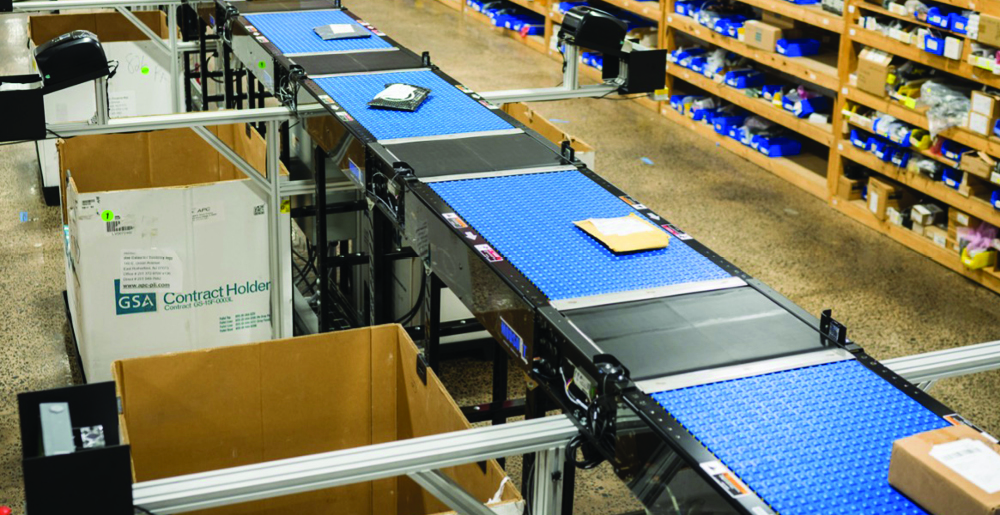
It’s a good time to be sorting parcels. This is a growth industry with long-term potential. According to Fortune Business Insights, the global parcel sorting system market size is estimated to grow from $3 billion in 2022 to $6.70 billion by 2029. This impressive forecast of growth bodes well for the future of ecommerce companies, 3PLs and fulfilment centers that are fulfilling parcel orders.
If you’re moving from manual to automated parcel sorting, or seeking additional, more efficient or supplementary sorting solutions, understanding the available technology options can help you identify the features that will work best for your specific operation and package types.
Each automated parcel sorting machine functions a little differently, but the main objective is for the machine to scan and sort parcels and automatically divert them to their intended destination. Automated systems greatly reduce the need for multiple workers by using conveyors to move the package through the system. Barcode readers scan the package label and then the system sorts them based on the information obtained.
Selecting the right sorting system technology is important to achieving the goals of your operation, however, it’s also important to consider what types of chutes and containers will work best for your requirements. These elements come in a range of sizes and functionalities. You will want to consider the general size and weight of your parcels, the type of packaging, and the fragility of the product that will be sorted.
Add-on technologies should also be considered as you look to maximize the productivity of your automated parcel sorting system. The right software, for example, can provide piece to container manifesting, a critical component to additional labor savings.
The main objective of automating parcel sorting is to increase the number of parcels that your operation can sort in a shorter period of time and at a lower cost. This results in a reduced processing cost per piece and greater capacity. And without the need for humans to manually sort, labor needs are reduced. This is one of the most significant ways the system pays for itself. Sort accuracy is also improved
In addition to sorting, automated parcel sorting systems can be enhanced with features that also help reduce shipping costs. These features include dimensioning and weighing packages significantly faster than manual processes. With this data and routing software, opimal shipping methods and rates are selected for the best shipping rates. Automatic systems are less prone to errors and more accurate. Automatic and manual labeling solutions can also be incorporated into the sorting system to achieveeffective labeling and sorting of parcels.
When it comes to the sorting process, a range of technologies are available. They each have their pros and cons. The following are some of the most common sorting technologies available.

The Divert and Transfer Roller Belt Sorter uses a transfer belt to receive and pass product through and a sperate divert belt to divert packages left or right. The throughput range is 35-50 parcels per minute. This sorter is modular in design and so it can be added to an existing or new conveyor system easily.
Pros: The Divert Transfer Roller Belt Sorter has no trouble running smaller packages and polybags because it does not have the gaps that are associated with pop-up transfer modules. The design is quiet, and provides a unique level of safety as it does not have as many catch points as some other designs. A small sorting system can easily be configured and installed with this technology and adding additional sorting outlets is easier than some other sorting technologies.
Cons: Throughput on this technology is relatively low and should be used for applications that don’t require high speed sorting. It is also designed for relatively smaller parcels and packets. It also becomes more expensive when many sorting outlets are needed.
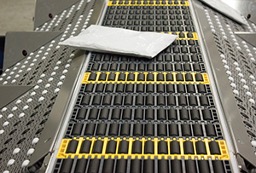
ARB Sorters use one long linear belt with diverting devices below it to activate rollers in the belt to divert left or right. These systems can achieve faster throughputs that range from 100-200 parcels per minute.
Pros: The active roller belt runs a very wide range of package types and sizes with no points for creating jams. Gaps between pieces can be smaller and layout of the sorting outlets can be flexible with 6” diverting zones. The range of size and weights that is can handle are quite large and faster than some other sorting solutions.
Cons: It is typically more expensive than some sorting technologies though not as expensive as others.
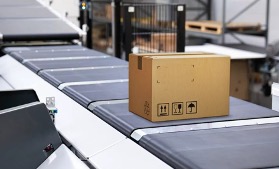
Cross Belt Sorters use conveyor belts that house two belts in one. The primary drive system moves the parcel carriers along the loop. When a parcel has reached the divert, a secondary belt, built into the carrier, is engaged and moves the parcel to its chute for sorting. This is a high throughout system that can sort 100-300+ cartons per minute.
Pros: This type of sorter can handle a wide range of products of varying weights and sizes while also being productive with a very high throughput. Cross Belt Sorters are also relatively quiet, which makes this a system with safety upside.
Cons: Due to the nature of the belt and chute system, Cross Belt Sorters are not optimal for more fragile packages. They are also one of the higher priced options, however they pay off with productivity if a customer’s volume supports the high capacity.
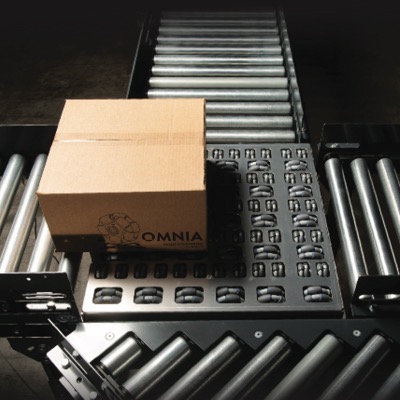
Multi Directional Sorter Tables use wheels with built-in rollers that can spin sideways. This lets them turn with very little sideways resistance and they can still grip when moving forward or backward. They can send parcels in any direction and can be combined to achieve a range of manipulations to divert, sort, merge, align, rotate and singulate at any angle.
Pros: Due to the unique nature of the technology, Multi Directional Tables can move parcels into position with great precision and at any angle, 365 degrees. The relatively simple mechanics of the table allows for low maintenance. They are compact in design and modular, so multiple units can be combined to perform more complex manipulations. Prices for small to medium size systems can be quite economical.
Cons: Throughput will depend on the angle of diverting with 90 degrees being slower. Packages must have a minimum weight of at least 6+ oz. Some items with a bottom surface that doesn’t engage well with the wheels may not divert properly.
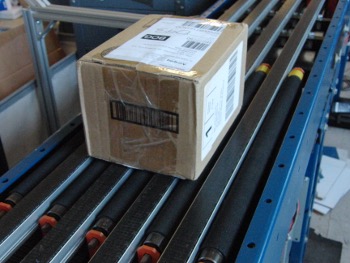
Items on Narrow Belt Sorters run on thin strips of belt that typically divert at 90 or 30-degrees. Rollers or Wheels between the belts raise up to change the position of a parcel at the divert. 30-degree systems provide a throughput range of 30-100 cartons per minute. 90-degree systems can sort 10-60 cartons per minute. These types of sorting machines are designed primarily for mid-sized parcels.
Pros: Narrow Belt Sorters are easily interchangeable and flexible for operations that are growing or changing use. They are also an economical choice with reasonable throughput for lower volume operations. They can handle a wide variety of package types as long as the size and bottom of the package engages with at least several of the narrow belts.
Cons: Not all parcels should be processed on Narrow Belt Sorters. The nature of their design makes it difficult for them to move very small or very large items. Packages with uneven bottoms may jam or not sort correctly.
Paddle Sorters, also referred to as a Pivoting Arm Sorter, uses a pivoting, rectangular, flat deflector arm (or paddle) to divert parcels to their diversion points. They rest along the conveyor at the the divert and swing out to guide the parcel to its destination. Paddle sorters are appropriate for a range of package types, from large to small. They are designed for low to medium throughput applications. Throughput is typically 30 - 100 parcels per minute.
Pros: The biggest upside to the Paddle Sorter is cost. This is a relatively low-cost option designed for specific sized packages that are mostly uniform in size. They are also durable and efficient at their intended use and therefore a reliable option.
Cons: Because of the nature of their design, Paddle Sorters are not ideal for fragile packages. They divert using considerable force. They are also not recommended for polybags because the bag can get caught under the pivot arm. This can cause damage to the package and/or require shutting the parcel sorting system down to get the bag dislodged. Finally, they typically are used for sorting to only one side of the sorting system or require significantly more linear space since paddles can not be directly across from each other.
Traditional Pop-Up Sorters house wheels, belts or rollers within the conveyor. They are raised up to move an item at an angle to different conveyor lines or to the divert. Typical sorters of this variety move parcels at a 30- or 90-degree angle. Pop-Up Sorters are primarily intended for parcels of uniform shape and size. Throughput is typically 40 - 100 parcels per minute.
Pros: Pop-Up Sorters are a relatively low cost and reliable option. The modular nature of this sorter type makes is ideal for adding and removing sections as needed.
Cons: This system is not optimal for handling low weight items or items of varying shapes, especially with uneven bottoms.

Pusher Sorters, also known as Push Sorters or Push Bar Sorters, use a series of pneumatically-actuated push bars mounted next to the conveyor. They can also use electric linear actuators that have a higher investment cost. The push bar is extended at a right angle to move the parcel to an alternate conveyor or chute. Throughput is typically 10 – 50 parcels per minute.
Pros: The durability of the pusher and relatively large surface area of the flat part of the push arm make Pusher Sorters an excellent choice for packaging that is unevenly weighted or shaped. They can also effectively manage poor quality packaging. The simple design means that costs are lower than some alternate options.
Cons: Throughput is lower. And because of the impact caused during the pushing motion, Pusher Sorters are not ideal for fragile packages. Pushers that use pneumatic air have a higher cost of operation versus those with electric motors which cost more upfront.
Similar to the Tilt-Tray Sorter, the Push Tray Sorter runs trays along a rail or track on a continuous loop. Items are pushed off the tray with a bar to the divert. Because the push bar functionality does not rely on gravity to move items, this type of sorting machine is effective for a wide range of parcels and packages including polybags, cartons, apparel, and other items that vary in size and shape. The average throughout is 30-60 cartons per minute.
Pros: Because the push bar technology is less jarring on merchandise than tilt tray sorters, which use gravity to divert, this system is better for more fragile items. These systems are also more cost effective than tilt tray sorters.
Cons: Throughput is relatively low and therefore this type of equipment is intended for operations that do not have high sorting volume requirements.
Sliding Shoe Sorters run a straight conveyor driven by chains on the side of the segmented deck. The conveyor is made up of thin aluminum slats. Plastic “shoes” are mounted to the top of the slats and moved into position to gently push the parcel to the divert. Shoe Sorters have traditionally been used to handle cases, but they are now being used for a range of package types. The throughput range on this type of system is 100-300 cartons per minute.
Pros: The Sliding Shoe Sorter is a high-speed option that can handle a wide range of items of varying shapes, sizes and weights. They also handle items gently, making them a good choice for fragile packets and parcels.
Cons: This type of system is more expensive than some comparable options and may require customization to meet specific parcel needs.
The Split Trat Sorter, also referred to as a Bomb-Bay (bombay) Sorter or Flat Tray Sorter), features two trays next to each other along the conveyor. The bottom of the trays open to drop out items at the divert and send the product to their intended chute or directly into a container below the sorter. Throughput for this type of sorting technology ranges from 100-230 trays per minute.
Pros: The Split Tray is often compared to the Tilt Tray due to their similarities. The Split Tray Is more affordable and still provides a very high rate of throughput. This is a durable technology that is also effective at handling loose, unbagged items.
Cons: The typical tray volume area is not suited for larger parcels. These sorters are often used for clothing and other smaller, lightweight items. Heavier items will exceed the tray weight capacity.
Tilt-Tray Sorters are often used to consolidate order line items or to sort return items that require immediate inventory processing. They work by moving trays that sit on moveable carts or mechanisms around a continuously looped track conveyor. Some smaller systems are linear. Packages are diverted to their destination when the trays are tilted to allow the item to slide off. Throughput can range from 100-300+ cartons per minute.
Pros: The Tilt Sorter provides some of the highest throughput of any automated sorter technology. This type of setup can also handle a wide range of different parcels and packages. They are also relatively quiet to operate.
Cons: These systems are costly when compared to other sorting technologies. They are also not ideal for handling fragile items. And because items are diverted using gravity, the package needs to be able to slide easily. Items made of materials that do not slide easily may not be appropriate for Tilt Trays as the item may not exit the Tilt Tray carrier.
Automated parcel sorting systems can reduce operating costs and improve the productivity and predictability of an operation. Choosing the system that is right for your specific needs and budget, however, can be daunting. With a wide range of available system types and features, it’s good to have a reliable partner to help guide you through the evaluation and selection process.
ID Parcel & Mail Solutions works closely with you from the start by first analyzing your operation. We then provide creative options on how to meet your business goals that balance capital requirements with savings and productivity. And then we deliver solutions designed to meet them. Since we specialize in smaller, more affordable systems, we can help new or growing operations or large operations that have supplemental system requirements. Reach out to ID Parcel & Mail Solutions today to start a discussion about how you can achieve your automation goals.